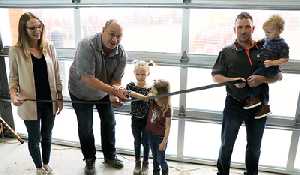Rail safety: Could a deadly derailment happen here?
July 16, 2013, 3:04 am
Kristen McEwen


In light of the tragedy of the train derailment at Lac Megantic, Que. on July 7, the question arises-could a similar tragedy happen in this area?
Derailments have occurred before in the area - a train derailed in St. Lazare in 1991, when 24 cars on a CN rail line derailed. Five of these cars were punctured, spilling acetic anhydride and methanol. The town was evacuated.
In 2009, a train was derailed on a CN rail line in the Spy Hill area spilling liquefied propane gas causing some of the tanker cars to explode and catch fire. Residents of Spy Hill were not forced to evacuate.
Almost all the communities in the area were built along the railway, and have tracks running through them.
While dangerous goods are carried by rail, if a train derailment was to occur in Moosomin, the Emergency Measures Organization (EMO), which consists of Mayor Larry Tomlinson and Councillor Lyndon Jacobs sharing the position of co-ordinator, would have no way of knowing what was on the train before the spill was to occur.
"It would be scary if you knew what went through here," Tomlinson said.
If there was a train derailment on the railway, the EMO has an emergency plan.
"We'd contact the railway to find out what's on that train," said Tomlinson.
"We have a full plan approved by the Fire Commissioner," said Jacobs. "Depending on what was spilled, fire department, police, whatever resources we need would respond - they're all listed in our plan, step-by-step as we go."
The Office of the Fire Commissioner with the Government of Saskatchewan enables communities to respond to emergencies and protect people and the environment from fire.
If a spill were to happen on the tracks, a binder of information kept the EMO, which contains all emergency plans, dictates who should be contacted and in what order.
First the Mayor and Council is contacted, followed by the Control Committee and the EMO co-ordinator, then the head of the fire department, police, power, public heads, welfare and health depending on where the incident occurs.
There's also a list of contacts to organize a labour effort if evacuation is in order.
If an evacuation ever was required, people would be sent to the Conexus MCC Centre, Tomlinson said.
Churches may also be used to shelter people.
The emergency plan for Moosomin also covers what to do in cases of large amounts of snowfall and where to look after people.
"We have actually used that plan two or three times," Tomlinson said.
"It's a large plan but that's the way the government wants it and we're pretty much up to spec with it," Tomlinson said.
The emergency plan is currently undergoing revisions the Fire Commissioner has recommended.
Souris-Moose Mountain MP Ed Komarnicki said that there is always concern for the safety of the public and safety precautions taken when moving dangerous goods.
"I do know that there's been a significant increase in the amount of oil that's shipped via rail in the recent number of months in the last year or so and we find ourselves in Saskatchewan where we have oil but we have to get it to market," he said.
"Pipelines is one way of doing it and trucking and railway is the other but when you see something like what happened in Quebec it's absolutely tragic, and I'm sure they will eventually investigate and find out what led to that, but there obviously needs to be safety regulations in place," Komarnicki said.
He mentioned that transporting oil by pipeline helps to isolate any potential problems to a small area.
"I guess one good thing about pipelines is you can isolate any problems you may have and they're below ground so you're not likely to have the same interaction with the travelling public or the public that are towns or communities because they generally by pass them or based on the edge of them so you've got that concern but again," he said. "There's only so much capacity for those as well. . ."
"My thoughts are that if we're going to transport by rail we need to be absolutely sure that the regulations are in place to make it safe and there are methods in place to ensure that safety."
Mark Hallman, director of Communications and Public Affairs with CN Rail, told the World-Spectator that safety is important to the railway.
"Railways in Canada and the United States are subject to extensive safety regulation. Rules and standards are prescribed for railway operations, track safety, freight cars, locomotives, work/rest provisions, and medical requirements. . .
"Data on the common types of dangerous goods being transported through local communities are useful for local emergency planners in developing effective and realistic emergency response plans. Any municipality, through its bona fide emergency planning and response organization, may request, in writing, Dangerous Goods Flow Information from CN for the sole purpose of emergency and contingency planning. Once in receipt of that information, the emergency planning and response organization must hold the information in confidence."
A response to why the information must be held in confidence and not made available to the public was not received by press time.
Transport Canada media relations senior advisor Maryse Durette responded via email that "Transport Canada maintains safety standards for trains travelling in both rural and urban areas."
"Employees must ensure the train is secure before leaving it unattended. The process is defined by the railway company based on their operational requirements. . .
"Each railway has instructions that further specify how many handbrakes are applied. These instructions also govern special circumstances such as a grade. The handbrake requirements are not load specific. Requirements are determined by the amount of cars, terrain, etc."
When the World-Spectator contacted CP about what safety measures and special precautions are in place when trains are carrying dangerous goods CP responded with an email, stating, "Out of respect to the residents of the Quebec community at the centre of this tragic incident and the investigations that are now taking place into the cause, CP will not provide direct comment at this time."



































